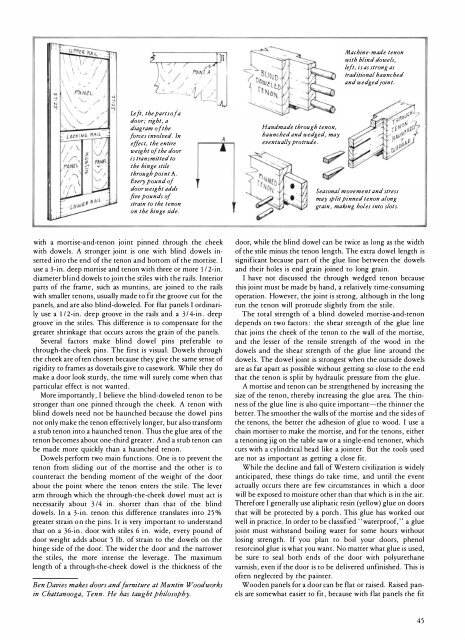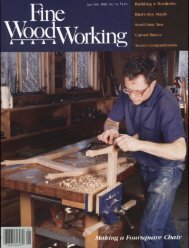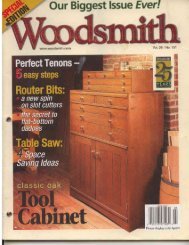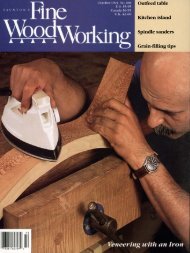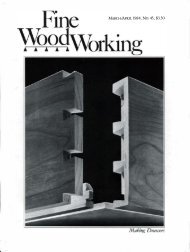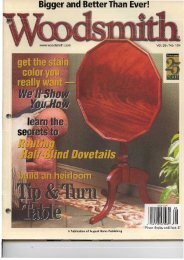orking - MetosExpo - Free
orking - MetosExpo - Free
orking - MetosExpo - Free
Create successful ePaper yourself
Turn your PDF publications into a flip-book with our unique Google optimized e-Paper software.
Machine-made tenon<br />
with blind dowels,<br />
left, is as strong as<br />
traditional haunched<br />
and wedged joint.<br />
Left, the parts of a<br />
door; right, a<br />
diagram of the<br />
fo rces involved. In<br />
effe ct, the entire<br />
weight of the door<br />
is transmitted to<br />
the hinge stile<br />
through point A.<br />
Every pound of<br />
door weight adds<br />
five pounds of<br />
strain to the tenon<br />
on the hinge side .<br />
A<br />
Handmade through tenon,<br />
haunched and wedged, may<br />
eventually protrude.<br />
Seasonal movement and stress<br />
may split pinned tenon along<br />
grain, making holes into slots.<br />
with a mortise-and-tenon joint pinned through the cheek<br />
with dowels. A stronger joint is one with blind dowels inserted<br />
into the end of the tenon and bottom of the mortise. I<br />
use a 3-in. deep mortise and tenon with three or more 1 I 2-in.<br />
diameter blind dowels to join the stiles with the rails. Interior<br />
parts of the frame, such as muntins, are joined to the rails<br />
with smaller tenons, usually made to fit the groove cut for the<br />
panels, and are also blind-doweled. For flat panels I ordinarily<br />
use a 1I2-in. deep groove in the rails and a 3/4-in. deep<br />
groove in the stiles. This difference is to compensate for the<br />
greater shrinkage that occurs across the grain of the panels.<br />
Several factors make blind dowel pins preferable to<br />
through-the-cheek pins. The first is visual. Dowels through<br />
the cheek are often chosen because they give the same sense of<br />
rigidity to frames as dovetails give to casework. While they do<br />
make a door look sturdy, the time will surely come when that<br />
particular effect is not wanted.<br />
More importantly, I believe the blind-doweled tenon to be<br />
stronger than one pinned through the cheek. A tenon with<br />
blind dowels need not be haunched because the dowel pins<br />
not only make the tenon effectively longer, but also transform<br />
a stub tenon into a haunched tenon. Thus the glue area of the<br />
tenon becomes about one-third greater. And a stub tenon can<br />
be made more quickly than a haunched tenon.<br />
Dowels perform two main functions. One is to prevent the<br />
tenon from sliding out of the mortise and the other is to<br />
counteract the bending moment of the weight of the door<br />
about the point where the tenon enters the stile. The lever<br />
arm through which the through-the-cheek dowel must act is<br />
necessarily about 3 14 in. shorter than that of the blind<br />
dowels. In a 3-in. tenon this difference translates into 25%<br />
greater strain on the pins. It is very important to understand<br />
that on a 36-in. door with stiles 6 in. wide, every pound of<br />
door weight adds about 5 lb. of strain to the dowels on the<br />
hinge side of the door. The wider the door and the narrower<br />
the stiles, the more intense the leverage. The maximum<br />
length of a through-the-cheek dowel is the thickness of the<br />
Ben Davies makes doors and furniture at Muntin Woodworks<br />
in Chattanooga, Tenn. He has taught phzfosophy.<br />
door, while the blind dowel can be twice as long as the width<br />
of the stile minus the tenon length. The extra dowel length is<br />
significant because part of the glue line between the dowels<br />
and their holes is end grain joined to long grain.<br />
I have not discussed the through wedged tenon because<br />
this joint must be made by hand, a relatively time-consuming<br />
operation. However, the joint is strong, although in the long<br />
run the tenon will protrude slightly from the stile.<br />
The total strength of a blind doweled mortise-and-tenon<br />
depends on two factors : the shear strength of the glue line<br />
that joins the cheek of the tenon to the wall of the mortise,<br />
and the lesser of the tensile strength of the wood in the<br />
dowels and the shear strength of the glue line around the<br />
dowels. The dowel joint is strongest when the outside dowels<br />
are as far apart as possible without getting so close to the end<br />
that the tenon is split by hydraulic pressure from the glue.<br />
A mortise and tenon can be strengthened by increasing the<br />
size of the tenon, thereby increasing the glue area. The thinness<br />
of the glue line is also quite important-the thinner the<br />
better. The smoother the walls of the mortise and the sides of<br />
the tenons, the better the adhesion of glue to wood. I use a<br />
chain mortiser to make the mortise, and for the tenons, either<br />
a tenoning jig on the table saw or a single-end tenoner, which<br />
cuts with a cylindrical head like a jointer. But the tools used<br />
are not as important as getting a close fit.<br />
While the decline and fall of Western civilization is widely<br />
anticipated, these things do take time, and until the event<br />
actually occurs there are few circumstances in which a door<br />
will be exposed to moisture other than that which is in the air.<br />
Therefore I generally use aliphatic resin (yellow) glue on doors<br />
that will be protected by a porch. This glue has worked out<br />
well in practice. In order to be classified ' 'waterproof, " a glue<br />
joint must withstand boiling water for some hours without<br />
losing strength. If you plan to boil your doors, phenol<br />
resorcinol glue is what you want. No matter what glue is used,<br />
be sure to seal both ends of the door with polyurethane<br />
varnish, even if the door is to be delivered unfinished. This is<br />
often neglected by the painter.<br />
Wooden panels for a door can be flat or raised. Raised panels<br />
are somewhat easier to fit, because with flat panels the fit<br />
45


